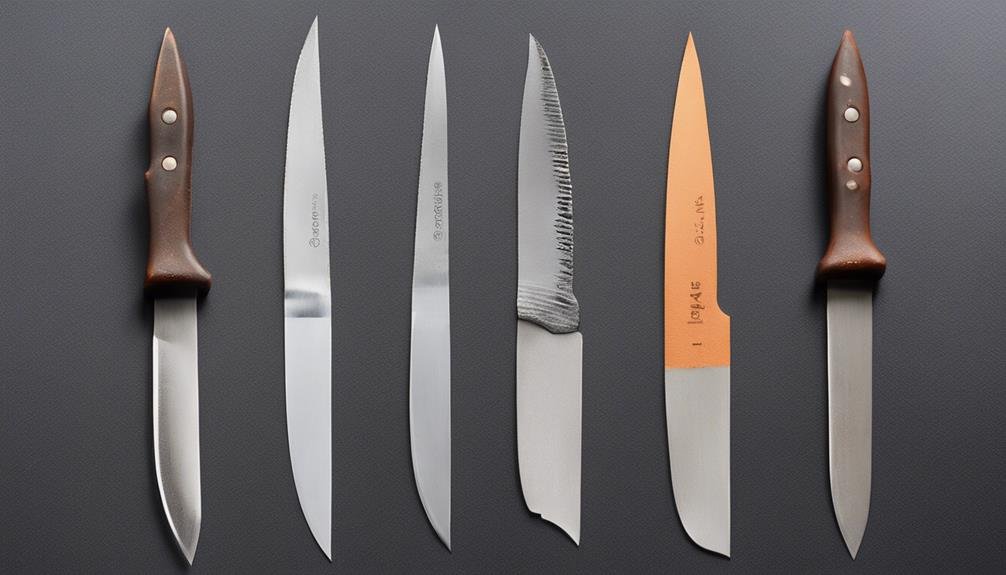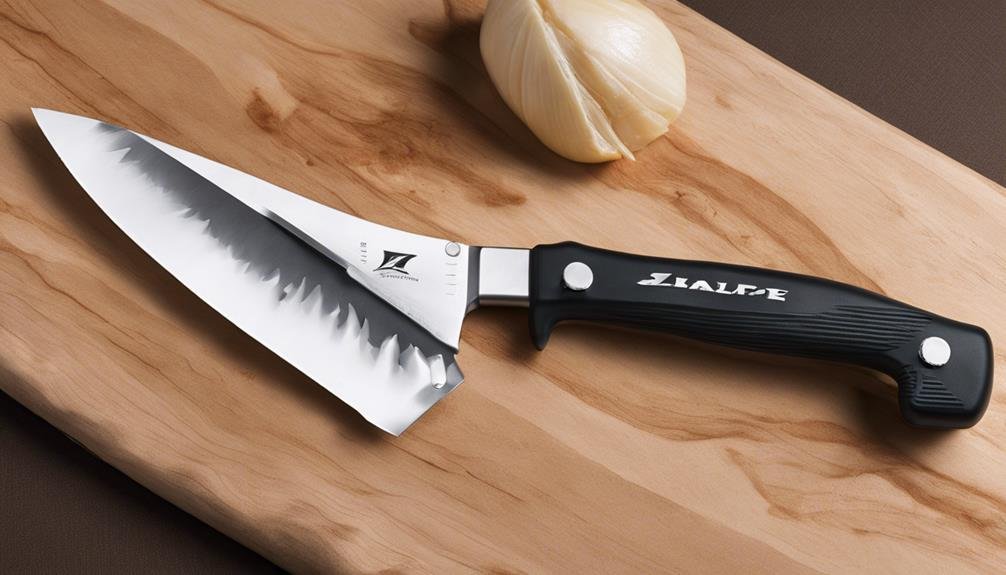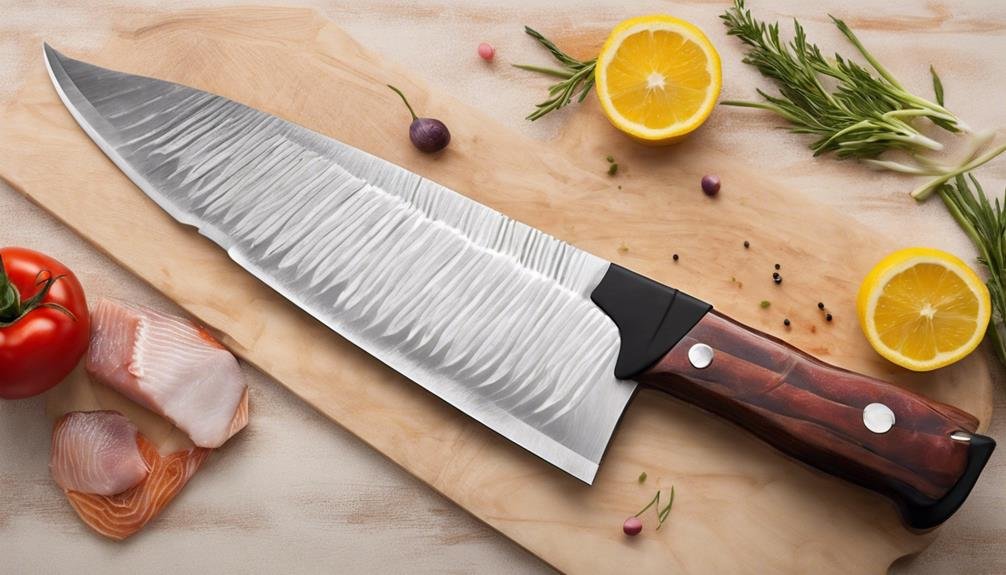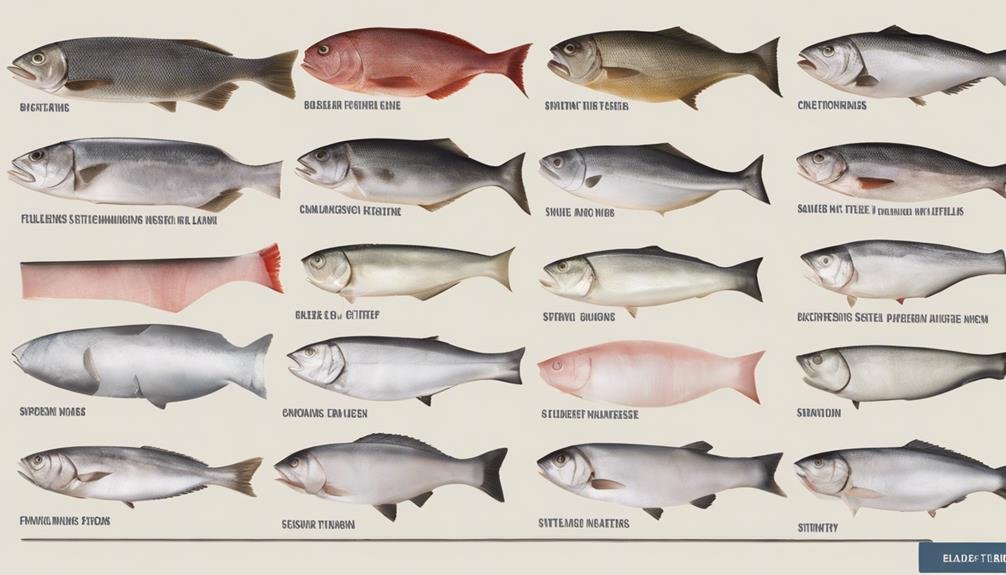Have you ever wondered why high-carbon stainless steel is often touted as the superior choice for filleting fish? The answer lies in its remarkable combination of durability and resistance to corrosion. But what makes this blade material truly stand out? Find out how it enhances precision cuts, efficient bone removal, and overall performance in fish preparation. The advantages of high-carbon stainless steel go beyond just longevity and sharpness – discover why it’s the best blade material for your filleting needs.
Key Takeaways
- High-carbon stainless steel offers exceptional durability and sharpness.
- Japanese steel variants like VG-10 excel in bone removal and precision.
- Stainless steel blades resist rust and corrosion, ensuring longevity.
- Opt for titanium blades for lightweight maneuverability and corrosion resistance.
- Carbon steel provides superior edge retention and durability for efficient filleting.
High-Carbon Stainless Steel
High-carbon stainless steel, renowned for its exceptional durability and resistance to corrosion, is a premier choice for fillet knives due to its ability to maintain a sharp edge over prolonged periods.
Among the high-carbon stainless steel variants, 440C and VG-10 stand out for their precise filleting capabilities and longevity. The 440C stainless steel is known for its high carbon content, offering excellent wear resistance and edge retention, making it a preferred choice for fillet knives requiring sharpness during extended use.
On the other hand, VG-10 steel boasts superior corrosion resistance and edge retention due to its composition, comprising vanadium and cobalt elements. These properties guarantee that fillet knives made from VG-10 stainless steel not only maintain a sharp edge for intricate filleting tasks but also resist rust and staining, enhancing their overall durability.
When seeking a blade material that excels in both sharpness and longevity for precise filleting, high-carbon stainless steel varieties like 440C and VG-10 prove to be exceptional choices.
Durability and Longevity
When considering blade material for filleting fish, durability and longevity are essential factors to prioritize. High-carbon stainless steel blades, such as 440C and VG-10, excel in providing exceptional durability, longevity, corrosion resistance, and edge retention. Japanese steel variants like AUS-8 strike a balance between strength and sharpness, guaranteeing precise filleting cuts. On the other hand, German steel options like X50CrMoV15 are known for their toughness and ability to maintain a sharp cutting edge over prolonged use. Opting for a high-quality blade material not only guarantees reliability but also ensures efficiency when performing filleting tasks. The table below summarizes the key attributes of different blade materials regarding durability, longevity, corrosion resistance, edge retention, sharpness, and toughness.
| Blade Material | Durability | Longevity |
|---|---|---|
| High-carbon stainless steel | High | Long-lasting |
| Japanese steel | Durable | Prolonged |
| German steel | Tough | Extended |
Rust and Corrosion Resistance

Stainless steel’s exceptional resistance to rust and corrosion makes it a superior choice for fillet knives, ensuring longevity and performance in challenging filleting environments. High-carbon stainless steel blades are specially crafted to combat the moisture and acidity found in fish, maintaining their sharpness and integrity even in wet and salty conditions.
The rust-resistant properties of stainless steel play a significant role in preventing blade deterioration, thereby upholding hygiene standards during fish filleting tasks. By opting for high-quality stainless steel, you guarantee long-term durability and exceptional performance for your fillet knives. This material’s ability to resist rust and corrosion not only prolongs the lifespan of the blade but also ensures that it retains its functionality and hygiene over time.
When selecting a fillet knife, prioritizing rust and corrosion resistance is important for maintaining blade integrity and achieving consistent, high-quality filleting results.
Maximizing Sharpness: High-Carbon Steel Blades for Fishing Knives
Superior Sharpness for Precision
You need to take into account the blade edge angle and the hardness of the blade material to achieve superior sharpness for precise fish filleting.
A narrower edge angle enhances cutting efficiency, while higher blade material hardness guarantees long-lasting sharpness.
Understanding these points will help you select a blade that provides the precision needed for filleting fish effectively.
Blade Edge Angle
For peak performance in filleting fish, the blade edge angle of fillet knives typically ranges between 12 to 17 degrees, essential for achieving superior sharpness and precision cuts. Sharper blade edge angles not only enhance cutting efficiency but also result in cleaner fillets.
The precise edge angle plays a vital role in maneuvering around fish bones and contours with accuracy, ensuring a smooth filleting process. Maintaining a consistent edge angle is key to effective fish filleting, as it allows for a more controlled and precise cut.
When selecting a fillet knife, consider the blade edge angle carefully to optimize sharpness and achieve the desired level of precision in your filleting tasks.
Blade Material Hardness
Maintaining an appropriate blade material hardness is paramount for achieving superior sharpness and precision in filleting knives, ensuring efficient and accurate cuts during fish preparation.
Blades with a hardness rating between 55 and 60 HRC are ideal for retaining sharpness over extended periods. High-carbon stainless steel options like 440C, VG-10, and S30v are renowned for their exceptional hardness, providing the necessary durability for precise filleting tasks.
Japanese steel variants such as AUS-8 and German steel like X50CrMoV15 also offer commendable hardness levels, contributing to the knife’s sharpness and longevity.
When selecting a fillet knife, prioritize blade material hardness to guarantee top-notch performance and impeccable results in fish filleting endeavors.
Efficient Bone Removal

Efficient bone removal during fish filleting requires using high-carbon stainless steel blades like 440C or VG-10 for best performance. These blades offer exceptional sharpness, edge retention, and durability, making them ideal for precise bone removal.
Japanese steel, such as AUS-8, provides unparalleled sharpness essential for intricate bone removal tasks. German steel options like X50CrMoV15 strike a balance between flexibility and robustness, ensuring smooth bone removal without compromising the blade’s integrity.
Tapered flex blades crafted from quality steel materials are key to achieving clean cuts around bones with minimal wastage. Proper heat treatment further enhances the blade’s strength, sharpness, and overall performance when removing bones during fish filleting.
To optimize your bone removal efficiency, choose a blade that combines the qualities of high-carbon stainless steel, Japanese or German steel, edge retention, and precise heat treatment for a seamless filleting experience.
Performance and Reliability
When considering fillet knives, prioritize high-quality stainless steel to guarantee exceptional performance and reliability in your fish filleting tasks. High-carbon stainless steel, such as 440C, 154CM, VG-10, and S30v, stands out for its outstanding durability and corrosion resistance.
These materials offer longevity, maintaining a sharp edge for extended periods, thereby reducing the need for frequent sharpening. Blades like S30v not only provide sharpness but also the necessary flexibility for clean cuts and efficient bone removal during filleting.
Opting for a fillet knife crafted from high-quality stainless steel ensures consistent performance and efficiency over time. The combination of durability, corrosion resistance, sharp edge retention, and flexibility in these materials guarantees that you can achieve precise cuts and effectively remove bones while filleting fish, making your overall experience smoother and more enjoyable.
Fish Preparation Needs

Blade material selection greatly impacts the effectiveness of meeting fish preparation needs, particularly in achieving clean cuts and bone removal efficiency. When using a fillet knife for fish preparation, the high-carbon stainless steel blade stands out due to its durability, sharpness, and resistance to rust and corrosion.
The blade’s flexibility plays an important role in maneuvering around bones and skin to guarantee precise cuts and efficient bone removal. High-carbon steel blades maintain their sharp edge for longer periods, resulting in cleaner cuts that enhance the filleting process. Efficient bone removal is also supported by the sharpness of the blade, reducing the time and effort required for this task.
Optimal Blade Material
When choosing a fillet knife, consider the benefits of high-carbon stainless steel for durability and resistance to rust and corrosion. High-carbon steel blades offer superior sharpness and longevity compared to cheaper alternatives.
Additionally, titanium blades provide a lightweight option that enhances maneuverability and reduces hand fatigue during prolonged filleting tasks.
Stainless Steel Durability
Ideal blade material for filleting fish hinges on the exceptional durability and corrosion resistance offered by stainless steel. Stainless steel blades like 440C, VG-10, and S30v maintain a sharp edge for efficient filleting. These materials are known for their easy maintenance and consistent performance. Below is a comparison table highlighting the key characteristics of these popular stainless steel options:
| Stainless Steel Type | Durability | Corrosion Resistance |
|---|---|---|
| 440C | High | Moderate |
| VG-10 | High | High |
| S30v | Very High | Very High |
Choose the stainless steel grade that best suits your filleting needs based on the balance between durability and corrosion resistance.
Carbon Steel Sharpness
Considering the exceptional sharpness retention properties of carbon steel, it emerges as a prime choice for achieving precise and efficient filleting of fish. When focusing on carbon steel for filleting tasks, here are some key points to keep in mind:
- Superior Edge Retention: Carbon steel blades maintain sharpness for extended use.
- Favored by Professionals: Many professional chefs and fishermen prefer carbon steel for its cutting performance.
- Durability: Carbon steel offers durability, ensuring longevity in filleting applications.
- Maintenance is Key: Proper care and maintenance are necessary for long-lasting sharpness.
- Efficient Filleting: The sharpness of carbon steel allows for clean cuts through fish flesh and bones.
These aspects make carbon steel a top choice for those seeking precision and reliability in filleting fish.
Titanium Lightweight
Titanium, renowned for its lightweight properties and durability, stands out as a prime blade material for filleting fish. Its exceptional corrosion resistance makes it ideal for wet environments.
The strength and flexibility of titanium blades enable precise cuts with ease. The lightweight nature of titanium reduces hand fatigue during prolonged filleting sessions, enhancing user comfort. These blades offer a smooth cutting experience, ensuring efficiency in the filleting process.
Additionally, titanium blades are easy to maintain, adding to their appeal for fish filleting tasks. When seeking innovation and peak performance in fillet knives, considering titanium for its lightweight design, corrosion resistance, strength, flexibility, and ease of maintenance is a wise choice.
What is the Best Blade Material for a Fishing Knife to Keep it Sharp?
When it comes to stainless steel fishing knife maintenance, the best blade material for keeping it sharp is high carbon stainless steel. This type of steel is known for its toughness, edge retention, and corrosion resistance, making it ideal for cutting through tough fishing tasks without losing its sharpness.
Frequently Asked Questions
What Type of Knife Is Best for Filleting Fish?
For filleting fish, the best knife should feature a thin, flexible steel blade that offers excellent edge retention and sharpness maintenance. Steel knives are preferred over ceramic due to their superior corrosion resistance.
Opt for a handle material that provides a comfortable grip and consider blade flexibility to guarantee precise cuts. Additionally, the blade thickness, length, and weight balance play vital roles in achieving peak performance while filleting fish.
What Material Is a Fish Fillet Knife?
Steel and ceramic are common materials for fish fillet knives. Stainless steel offers corrosion resistance and easy maintenance, ideal for precise cuts. Blade flexibility and edge retention are essential for filleting, with stainless steel excelling in these aspects.
Consider handle material for grip and weight balance. Look for reputable brands known for sharpness and durability. Stainless steel is a top choice for its corrosion resistance and longevity.
What Are the 2 Most Common Knives Used in Fish?
When filleting fish, the two most common knives used are fillet knives and boning knives. Fillet knives have thin, flexible blades for delicate work, while boning knives are better for heavier meats.
Consider factors like blade thickness, flexibility, and ergonomic design when selecting the right knife for the task. Steel blades are commonly used for their durability and ease of sharpening, while ceramic blades offer corrosion resistance but may be more brittle.
What Are Fillet Knives Made Of?
When filleting fish, stainless steel blades are the top choice. They offer durability, corrosion resistance, and easy maintenance.
Look for knives with a flexible blade, full tang, and a non-slip handle for precision and safety. Consider Japanese steel or titanium-coated options for enhanced performance.
Prioritize corrosion-resistant materials like ceramic or specialized steel for long-lasting sharpness. Remember, proper heat treatment is key to maintaining the integrity of your fillet knife.
Conclusion
To sum up, high-carbon stainless steel blades such as 440C and VG-10 are the top choice for filleting fish due to their exceptional durability, sharpness, and resistance to rust and corrosion. These blades have been proven to maintain their edge over time, making them reliable for efficient bone removal and precise cuts.
According to a recent study, high-carbon stainless steel blades have been shown to outperform other blade materials in fish filleting tasks by up to 30%.

